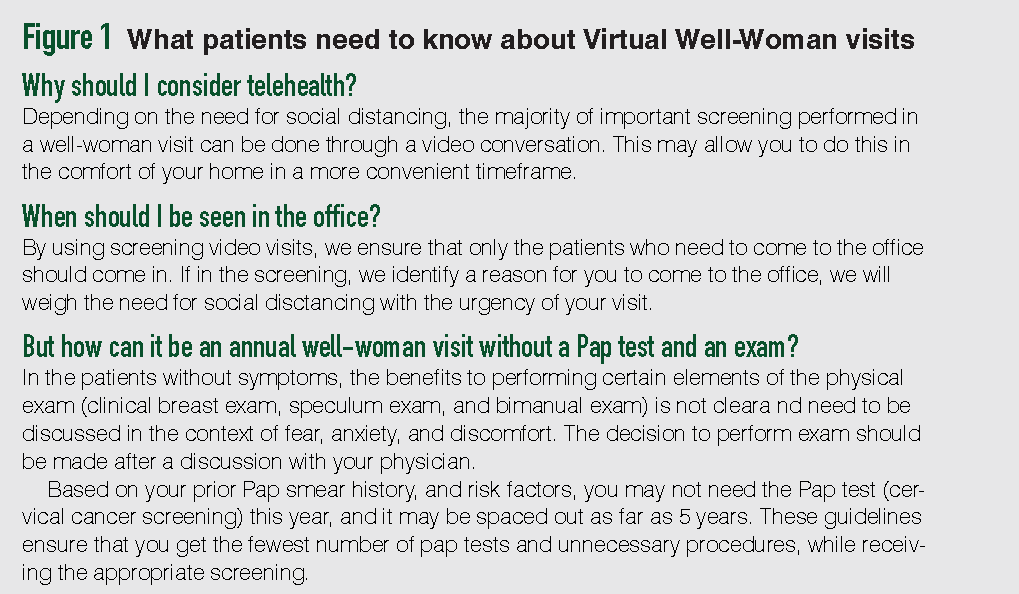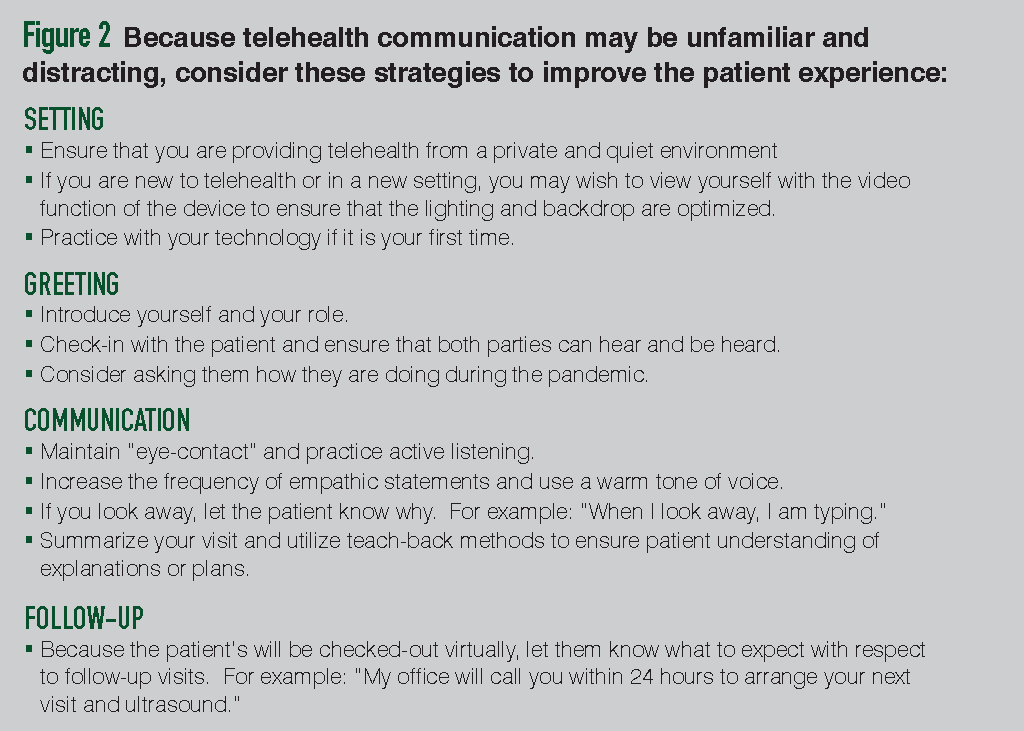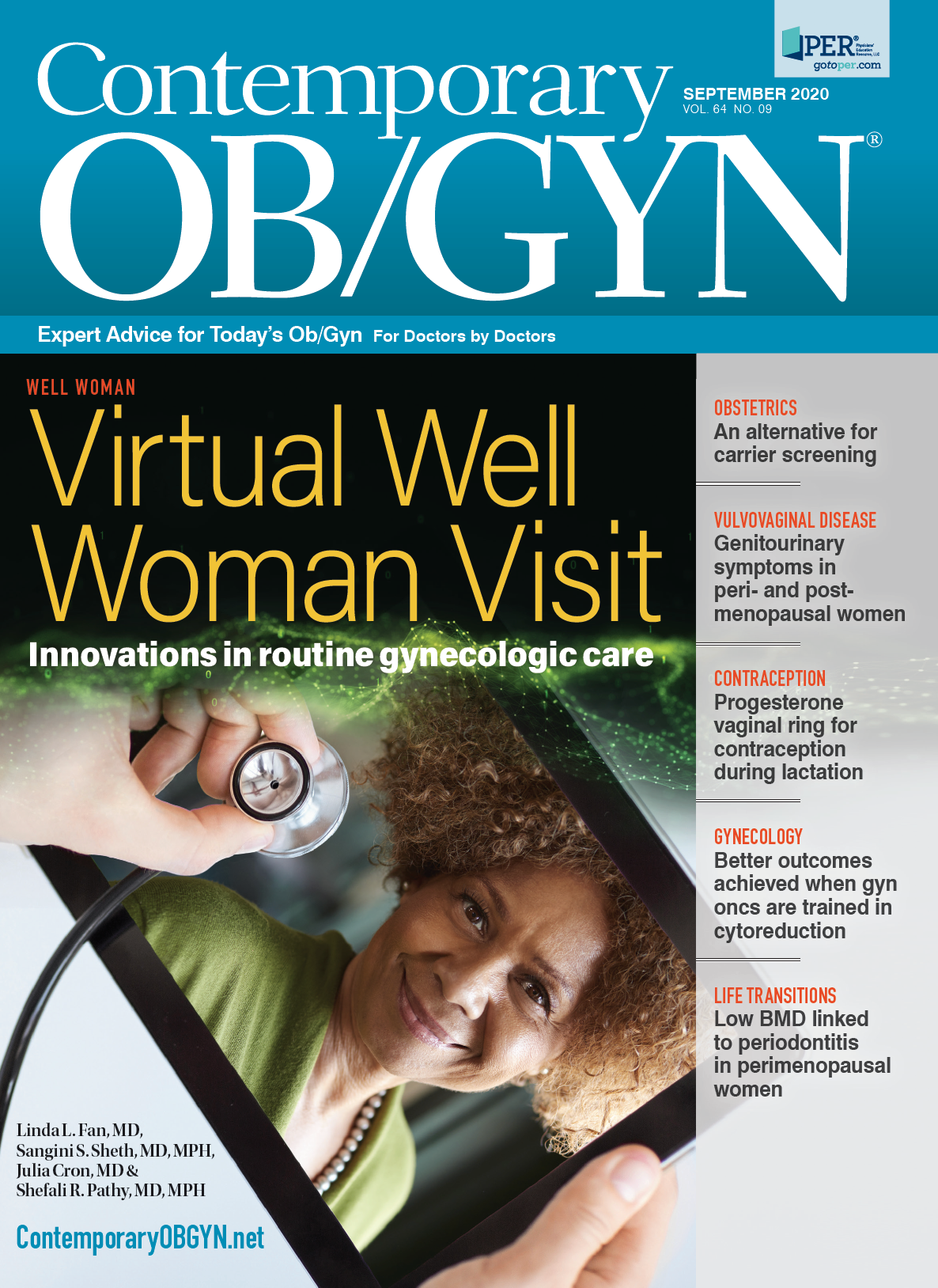Guide to effective virtual visits during COVID-19
As the pandemic forces health care to adapt, virtual Well Woman visits can be offered as a safe approach to timely care.
During the COVID-19 pandemic, collaboration of insurance carriers, physicians, healthcare systems, and use of technology have allowed for accelerated uptake of telehealth. These innovations have been leveraged to respond to the changing needs of patients in an unpredictable landscape.
Because this pandemic is not transient, ob/gyn practices may need to further evolve to provide full-spectrum care for women remotely. Virtual Well-Woman Visits should be offered as a safe approach to timely care.
The decision to offer these virtual visits is patient-specific and may serve a purpose, depending on time and geography, particularly as some locations brace for the possibility of a second wave of the SARs-CoV-2 virus. Some practices may decide to incorporate this type of visit as an option for patients as a convenience or to maintain appropriate social distancing. Others may use it as a structured triaging tool to balance the urgency of in-person visits.
Because of their seemingly non-urgent nature, well-woman visits are prone to rescheduling or cancellation, by both patients and practices.
However, preventive measures addressed during these visits are crucial to maintaining positive health outcomes.1 Deferring screening for too long can result in avoidable urgent and emergent scenarios. Women who often face primary childcare responsibilities will be further challenged by distance learning, and social isolation may open the door for worse domestic violence and mental health concerns.
Given the uncertain duration of the COVID pandemic, the need to advocate for routine women’s health services in a patient-centered manner is essential.
Using screening guidelines to streamline your practice
Periodic screening guidelines for female patients are continually reassessed by multiple professional organizations, including the American College of Obstetricians and Gynecologists (ACOG), the United States Preventive Services Task Force (USPSTF), and the American Society for Colposcopy and Cervical Pathology (ASCCP) for evidence regarding efficacy, optimal frequency, and potential for harm. Because the current guidelines for well-woman care have moved away from the obligatory yearly pelvic exam, there is an opportunity to offer remote well-care visits.
Becoming familiar with these guidelines and incorporating them into ambulatory practice can enhance efficient patient care. A checklist or template that reflects the latest guidelines can streamline workflows and allow for a fluid virtual well-woman visit. Screening during this visit can then guide subsequent care while minimizing unnecessary visits experienced by patients.
Table 1 is a comprehensive list of health maintenance issues that are ideal for an initial virtual assessment.
Because essential elements of the traditional well-woman visit include screening, it can be used to provide guidance in follow-up visits. For example, a 62-year-old with COVID-19 risk factors who presents for a virtual annual visit would benefit from a full clinical assessment of her health maintenance needs.
In providing the necessary care, if the patient is asymptomatic and up to date on her mammography and Pap test, she may not require in-office breast and pelvic examination. However, the patient may benefit from counseling about cardiovascular risks, lifestyle modifications, psychosocial stressors, and sexual well-being—all topics suitable for a virtual visit.
If the patient’s history reveals abnormal cervical cancer screening, the clinician may be compelled to consider the risks and benefits of scheduling the necessary in-office visit (repeat Pap test vs colposcopy).
The human touch in telehealth
A well-designed approach to the virtual well-woman visit should preserve the essence and breadth of care provided at a traditional health maintenance visit. Press-Ganey scores have indicated that positive patient experience and loyalty are driven by indicators that can be implemented virtually: coordination of care, confidence in the care provider, responsiveness to patient concerns, listening, and courtesy.2
Patients may also find personal protective equipment intimidating, particularly if they are already anxious and afraid about the pandemic. An inability to read faces and emotional response, as well as muffled voices, may impede clear communication.3
A face-to-face interaction between patient and provider, in the comfort of their own home, can help re-engage individuals in their healthcare. Telehealth has been shown to provide comparable health outcomes without compromising the patient-physician relationship and in fact, has been shown to enhance patient satisfaction and engagement.1,3
Enhanced communication via telehealth can be achieved through a multifaceted strategy. First, the patient must be engaged in understanding the rationale and safety of virtual well-woman visits.
Figure 1 demonstrates examples of scripted explanations providers can share with patients. Second, physician practices and hospital systems need to reassess resources to ease a patient’s transition into telehealth.
Figure 1: What patients need to know about Virtual Well-Woman visits

A three-stage approach is effective in achieving this transition: 1. Use of patient portal electronic messaging with instructions for accessing and using the telehealth platform; 2. Review of the telehealth platform by the staff scheduling the visits; and 3. A process for virtual rooming of the patient the day of the visit.3
Other simple steps that can optimize the patient experience and facilitate an environment conducive to open communication are summarized in Figure 2. Because this is, by and large, a new approach to patient care, practices should consider adopting such a workflow to standardize the virtual visit.
Figure 2: Because telehealth communication may be unfamiliar and distracting, consider these strategies to improve the patient experience

“But don’t I need a pelvic exam every year?”
The changing landscape of preventive medicine, including the need for routine pelvic and breast exams and breast and cervical cancer screening, can often cause confusion for patients. Certainly, for patients who are symptomatic, ob/gyns should continue to perform exams as indicated.
However, the necessity of certain portions of the gynecologic exam in asymptomatic patients has been called into question. While the sensitivity of bimanual exam in screening for ovarian cancer is low, 82% of patients believe that the exam provides reassurances of their gynecologic health.4
It is ingrained in patients that the well-woman exam is synonymous with the pelvic exam and Pap test. However, cervical cancer screening guidelines have progressively shifted over the last two decades toward the goal of reducing the number of unnecessary tests women receive over their lifetime “to better ensure that they receive the benefits of testing while minimizing the harms.”5
Because there is potential for patient anxiety and discomfort with pelvic exams, and the benefits of the pelvic exam in an asymptomatic patient are unclear, the well-woman task force states “the need for a pelvic exam for screening should be determined through shared decision making.” 6,7 Consequently, telehealth visits are ideal for this shared discussion between patient and clinician, and allow for the determination of subsequent office visits for an examination.
The pandemic is not over…
Reimbursement for well-care visits is dependent on payer and individual states. Some states have mandated payment parity for telehealth well-care visits in their Medicaid or private health care plans.
As the COVID-19 crisis continues, states should continue to advocate for appropriate payment of this safe, patient-centered approach. This includes ensuring parity in reimbursement. During this pandemic, ob/gyns must be allowed to offer all options. Innovation is vital to ensure exceptional and timely care of women.
The virtual Well-Woman exam will not replace the cornerstone of ambulatory ob/gyn practice—the face-to-face annual visit—but it can be used as an alternative for patients. Patients may feel nervous about in-person visits and entering medical facilities. Shelter-in-place orders vary from month to month, and the idea of a masked visit with their doctor may feel daunting.
Gynecologic care may not be seamless during the COVID pandemic; however, incorporating the virtual well-woman visit into the repertoire of ambulatory ob/gyn practice may allow patients to experience a more fluid provision of care.
The virtual Well-Woman visit is an ideal opportunity to promote healthy lifestyles, ensure appropriate screening for various conditions, and counsel patients on risk-reducing behavior.
Successful adoption and uptake of telehealth may allow for interventions and care of patients at an unprecedented rate. While some healthcare disparities have surfaced related to technological barriers to telehealth, in many ways, virtual visits may improve access to routine healthcare for women who have been encumbered by social distancing, work challenges, lack of transportation, and childcare.
Women’s healthcare faces innumerable challenges, from access to family planning to shifting insurance coverage, emphasizing the need to reassure patients that all aspects of their health are important, even during the COVID-19 pandemic.
__
Author biographies
Dr. Fan is an assistant professor of obstetrics, gynecology and reproductive services; director of the Gynecology Section; and Co-Chair of the Gynecologic Services Quality Assurance Committee at Yale University School of Medicine.
Dr. Cron is an assistant professor and residency program director in obstetrics, gynecology and reproductive sciences at Yale University School of Medicine.
Dr. Pathy is assistant professor and clerkship director in obstetrics, gynecology and reproductive sciences; and medical director at YNH Women’s Center at Yale-New Haven Hospital Primary Care Center.
Dr. Sheth is an associate professor of obstetrics, gynecology and reproductive services; associate medical director and director of colposcopy and cervical dysplasia at Yale New Haven Hospital.
__
References
- American College of Obstetricians and Gynecologists. COVID-19 FAQs for obstetricians-gynecologists, telehealth. Washington, DC: ACOG; 2020. Accessed on July 29, 2020. Available at: https://www.acog.org/clinical-information/physician-faqs/covid-19-faqs-for-ob-gyns-telehealth.
- Press Ganey. Protecting market share in the era of reform: understanding patient loyalty in the medical practice segment. 2013. Press Ganey Associates, Inc. Accessed on July 29, 2020. Available at: https://www.pressganey.com/resources/whitepapers/understanding-patient-loyalty-in-the-medical-practice-segment[J1]
- Millstein JH, Kindt S. Reimagining the patient experience during the Covid-19 pandemic. NEJM Catalyst. Available at https://catalyst.nejm.org/doi/full/10.1056/CAT.20.0349 Accessed July 31 2020.
- ACOG Committee Opinion No. 754: The Utility of and Indications for Routine Pelvic Examination, Obstet Gynecol. 2018 Oct;132(4): e174-e180.
- Perkins RB, Guido RS, Castle PD, et al; for the 2019 ASCCP Risk-Based Management Consensus Guidelines Committee. 2019 ASCCP Risk-Based Management Consensus Guidelines for Abnormal Cervical Cancer Screening Tests and Cancer Precursors. J Low Genit Tract Dis. 2020; Apr; 24(2):102-131.
- ACOG Committee Opinion No. 755: Well-Woman Visit. Obstet Gynecol. 2018 Oct;132(4):e181-e186.
- C JA, Brown H. Well-Woman Task Force: Components of the well-woman visit. Obstet Gynecol. 2015 Oct; 26(4): 697-701.

Contemporary OB/GYN Senior Editor Angie DeRosa gets insight on the current state of COVID-19 from Christina Han, MD, division director of maternal-fetal medicine at the University of California, Los Angeles, and member of its COVID-19 task force. Han is an active member of the Society for Maternal-Fetal Medicine and discusses the issues on behalf of SMFM.
Listen
